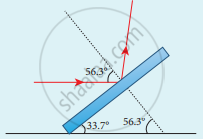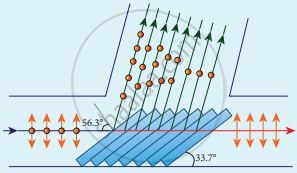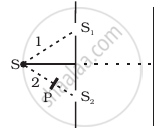Advertisements
Advertisements
प्रश्न
Discuss about pile of plates.
उत्तर
- The phenomenon of polarisation by reflection is used in the construction of pile of plates.
- It consists of a number of glass plates placed one over the other in a tube
- The plates are inclined at an angle of 33.7°(90° – 56.3°) to the axis of the tube. A beam of unpolarised light is allowed to fall on the pile of plates along the axis of the tube. So, the angle of incidence of light will be at 56.3° which is the polarising angle for glass.


Pile of plates - The vibrations perpendicular to the plane of incidence are reflected at each surface and those parallel to it are transmitted.
- The larger the number of surfaces, the greater is the intensity of the reflected plane polarised light.
- The pile of plates is used as a polarizer and also as an analyser.
APPEARS IN
संबंधित प्रश्न
What is a Polaroid?
Draw a neat labelled diagram showing the plane of vibration and plane of polarisation for polarised light.
For a glass plate as a polariser with refractive index 1.633, calculate the angle of incidence at which light is polarised.
Two polaroids P1 and P2 are placed with their pass axes perpendicular to each other. Unpolarised light of intensity I0 is incident on P1. A third polaroid P3 is kept in between P1 and P2 such that its pass axis makes an angle of 60° with that of P1. Determine the intensity of light transmitted through P1, P2 and P3.
A ray of light passes from a vacuum to a medium of refractive index (μ). The angle of
incidence is found to be twice the angle of refraction. The angle of incidence is _______.
A) `cos^(-1)(mu/2)`
B) cos−1(μ)
C) `2 cos^(-1) (mu/2)`
D) `2 sin^(-1) (mu/2)`
Unpolarised light is passed through a polaroid P1. When this polarised beam passes through another polaroid P2 and if the pass axis of P2 makes angle θ with the pass axis of P1, then write the expression for the polarised beam passing through P2. Draw a plot showing the variation of intensity when θ varies from 0 to 2π.
With the help of an experiment, state how will you identify whether a given beam of light is polarised or unpolarized?
A beam of light is incident at the polarizing angle of 35° on a certain glass plate. The refractive index of the glass plate is :
Green light is incident at the polarising angle on a certain transparent medium. The angle of refraction is 30° . Find
(i) polarising angle, and
(ii) refractive index of the medium.
Discuss polarisation by selective absorption.
What is partially polarised light?
State and obtain Malus’ law.
List the uses of polaroids.
How is polarisation of light obtained by scattering of light?
What is normal focusing?
Can reflection result in plane polarised light if the light is incident on the interface from the side with higher refractive index?
Figure shown a two slit arrangement with a source which emits unpolarised light. P is a polariser with axis whose direction is not given. If I0 is the intensity of the principal maxima when no polariser is present, calculate in the present case, the intensity of the principal maxima as well as of the first minima.

To ensure almost 100 per cent transmissivity, photographic lenses are often coated with a thin layer of dielectric material. The refractive index of this material is intermediated between that of air and glass (which makes the optical element of the lens). A typically used dielectric film is MgF2 (n = 1.38). What should the thickness of the film be so that at the center of the visible spectrum (5500 Å) there is maximum transmission.
